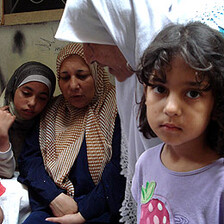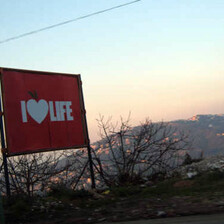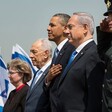Beirut 23 August 2006
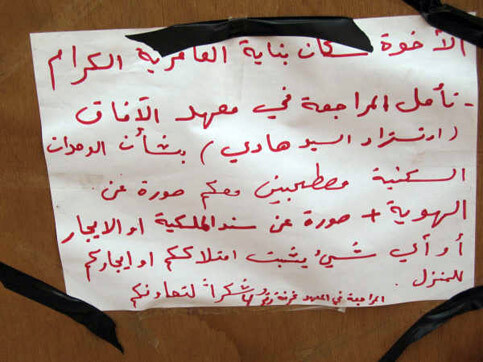
A note to the residents of Amiriyyah building in south Beirut
“To the residents of the Amiriyyah building Please visit the Afaq Center, Sayyid Hadi bridge. Please bring along any paper that proves your rent or ownership of a unit in the building. Thank you for your cooperation.”
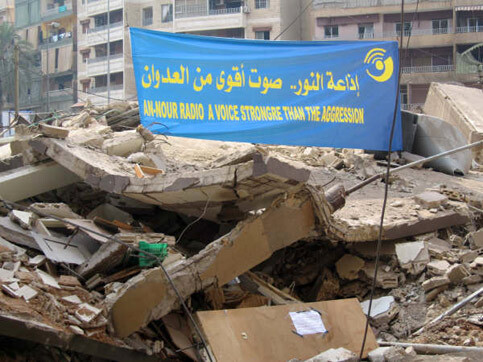
The former site of Nour Radio Station
Thus read a sign on the rubble of a leveled building in south Beirut. The building was hit by a bunker buster on 13 of July 2006, the second day of the war, when the Israeli Air Force hit the Nour Radio Station that used to operate from the Amiriyyah building.
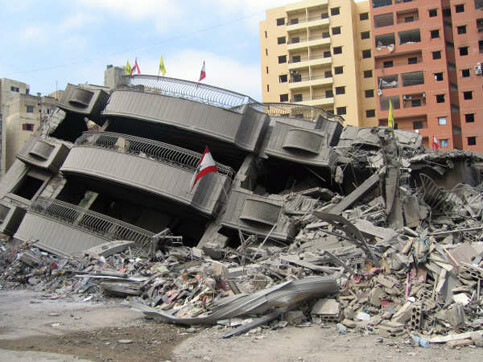
Destruction in south Beirut
Amiriyyah is a name that takes us to the first Gulf War, specifically to 13 February 1991, when the United States Air Force committed a massacre in the air raid shelter of Al-Amiriyyah in North Baghdad. The shelter was hit by two bunker busters, missiles tried for the first time on Al Amiriyyah, and which left 403 Iraqis dead, 142 of them children under the age of ten. The first of the two penetrating missiles made a hole in the roof in its only vulnerable point, the ventilation system, the exact location of which provided to the US by the Finnish construction company that had built the shelter years before. A few minutes later, another smart missile got in through the hole opened by the first, producing a fireball that incinerated those inside, “leaving like in Hiroshima and Nagasaki only a silhouette of many of them engraved on the ceiling and walls,” as one observer put it.

Destruction in south Beirut
The death of the 403 Iraqis in the shelter and thousands others were counted as collateral damage for the American Desert Storm operation. Under the rubric of “liberating Kuwait from Saddam”, a multinational intervention led by the US waged a war against Iraq, during which the civilian infrastructure and country’s means of production were systematically destroyed. The “coalition forces” ran 109,876 bombing missions; one every 34 seconds, through which 22,000 civilian installations of all types, from bridges to dams to museums and schools to factories were destroyed with a tonnage of bombs twice that deployed during the Vietnam War. According to the UN, the destruction caused by the war cost Iraq 22 billion dollars. It also left the legacy of depleted uranium residue that still poisons the population today.

A destroyed road in south Beirut
The US justified its attack on Al-Amiriyyah by claiming that the shelter hosted a military communications center, a lie that was easily refuted by the international press. The Pentagon then claimed that an “error” had been made. However, the attack was premeditated without mistake. The real object was to terrorize the civilian population, creating a feeling of vulnerability that would lead to a revolt and thus the toppling of the Saddam regime.
Although during the forty days of Operation Desert Storm Iraqi soldiers were driven out of Kuwait, Iraq was subsequently put under a decade of sanctions that caused the death of more than a million Iraqis, half of whom were children - deaths that US Secretary of State Madeleine Albright infamously once said were “worth the price.” The sanctions were not lifted until America’s Operation Iraqi Freedom was waged in 2003, a war that left more than tens of thousands of Iraqis dead and drove the country into civil unrest, a war waged on the premise of destroying weapons of mass destruction that Saddam allegedly possessed and liberating Iraqis from their dictator to promote democracy and create a new Middle East.

Residents survey the destruction of their neighborhood
Fifteen years passed between 13 February 2006, the day of the massacre of Al-Amiriyyah shelter in Baghdad, and 13 August 2006. After more than fifteen years, The Amiriyyah building in the southern part of Beirut was hit by a bunker buster tried first in Iraq, but this time it was used by the Israeli Air Force, during a war that was it initially claimed was meant to liberate two Israeli soldiers abducted by Hizbullah but actually set rebuilt Lebanon back fifty years. The destruction of the Amiriyyah building is part of the US-Israel war on Lebanon, during which Lebanon’s civilian infrastructure - over 100 bridges, 31 vital installations and more than 15,000 housing units and 900 commercial buildings, including factories - were systematically destroyed by more than 10,000 bombing missions. According to UN estimates, the destruction caused by the one month war will cost Lebanon around 13 billion dollars. The destruction of civilian infrastructure and the death of more than a thousand civilians - more than 39 massacres in 31 days - are US Secretary of State Condoleezza Rice suggested, the birth pangs of a New Middle East. In other words, worth the price. As with the US wars on Iraq, the high-intensity war on Lebanon intended to break the will of the people through terrorizing Lebanese civilians, in order to push for the disarming the of resistance, set Lebanon back fifty years — in other words, to make Lebanon, like Iraq, a developing country. Having failed to accomplish their goal to disarm Hizbullah during the war, the US and its proxy state Israel now maintain a siege on Lebanon, and who knows if the Iraqi scenario of a decade-long blockade will be repeated when “Operation Lebanese Freedom” will be waged.
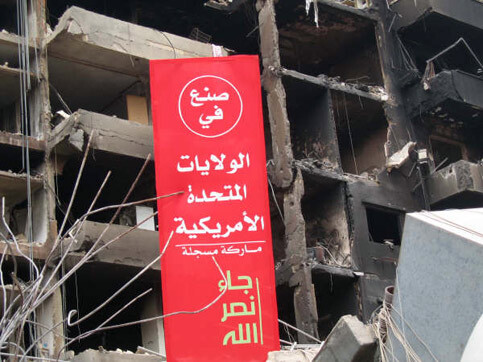
A sign that reads “Made in the USA” in south Beirut
At the rubble of Amiriyyah in Beirut, we try to make the link between the Amiriyyah in Iraq. Almost none of those who visit it know what happened in Al-Amiriyyah shelter in Baghdad. Fifteen years of US-led media has erased the memory, so the people of the area do not see the connection. Fifteen years of US misinformation buried the fact that what binds Al-Amiriyyah in Baghdad and Amiriyyah in Beirut is more than a name — it is a US imperial project initially coated in the rhetoric of liberation and now that of democracy. What binds the two Amiriyyahs is the creation of a “new Middle East”, the imposition of which is being met with resistance from Iraq to Palestine to Lebanon.
During the fifteen years between the war for the liberation of Kuwait and the war for the liberation of the two abducted Israeli soldiers are fifteen years, many other Al Amiriyyahs in Palestine, Iraq and Lebanon were committed by both the US and Israeli aif forces. Hiding behind concepts such as liberation, democracy and self-defense, the US and Israel have reached a state of total impunity, where no apology is required for the death and destruction they commit.

Destruction in south Beirut
Civilians are no longer counted as collateral damage. After all, aren’t we all complicit with the terrorists, as Alan Dershowitz claims?
Between Al-Amiriyyah of Baghdad, and Amiriyyah of Beirut there is more than a name for those who want to connect the dots and understand. Until then, our Amiriyyahs - the Arabic root of which means life and construction - will be turned into death and destruction. Until then, will our Amiriyyahs, which also means to develop a new place, be brought back a further fifty years?
Mayssoun Sukarieh is a native of Beirut
Related Links
